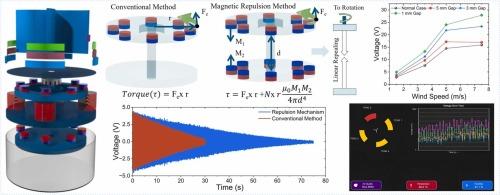具有非接触式摩擦电传感器的磁斥力辅助混合式微风风能采集器,用于自维持设备调节和环境监测应用
IF 17.1
1区 材料科学
Q1 CHEMISTRY, PHYSICAL
引用次数: 0
摘要
从缓慢且不稳定的微风中产生大量能量是传统风能收集器面临的主要挑战。本文提出了一种磁斥力辅助混合微风风能采集器(MR-HWEH),包括电磁发电机(用于收集低随机环境风)和非接触式单电极自供电摩擦电传感器(NC-SPTS)(用于检测风速、风向和自维护警报以监测设备状态)。基于磁斥力的悬浮支撑了涡轮机和旋转层的重量,从而降低了其有效质量,萨福纽斯涡轮机对叶片提供了更高的阻力,使其能够在低随机风下高效旋转,排斥力使旋转持续时间延长了2.5倍。顶部运动层和底部静止层具有8个排斥性磁铁,中间有一个静止线圈层,在运动层近地点和外壳内壁上有4组NC-SPTS。该电磁发生器在低随机风速为3 ms-1时,平均功率密度可达14.08 Wm-3。此外,由尼龙6/6和PVDF-HFP对组成的NC-SPTS可以有效地检测风速(2.91 V/ms-1; 1.5-5 ms-1和0.642 V/ms-1; 6至14 ms-1)和风向。此外,该方法还可以检测非接触间隙因不一致和随机的高风速而产生的变化,并利用自维护报警信号来估计设备的故障。最后,将能量收集和风力监测功能与MCU、BLE和多功能环境监测传感器(空气质量、湿度、温度)集成在一起,成功展示了未来自主环境监测应用的自我可持续户外物联网监测系统。本文章由计算机程序翻译,如有差异,请以英文原文为准。

Magnetic repulsion-assisted hybrid breeze wind energy harvester with non-contact triboelectric sensor for self-sustainable device conditioning and environmental monitoring applications
Generating substantial energy from slow and inconsistent breezy wind is a major challenge for conventional wind energy harvesters. Herein, a magnetic repulsion-assisted hybrid breeze wind energy harvester (MR-HWEH) is proposed, comprising an electromagnetic generator to harvest low and stochastic ambient wind and non-contact single electrode self-powered triboelectric sensors (NC-SPTS) to detect wind speed, direction, and self-maintenance alerting for monitoring device condition. The magnetic repulsion-based levitation supports the weight of the turbine and rotating layer, thereby reducing its effective mass, savonius turbine offers higher drag force on the blade, allowing it to rotate at low stochastic wind efficiently, and the repulsive force extends the rotational duration by 2.5 times. The top moving and bottom stationary layers have eight magnets in repulsive configuration, a middle stationary coil layer, and four sets of NC-SPTS across the perigee of moving layer and inside wall of enclosure. The fabricated electromagnetic generator (EMG) can deliver an average power density of 14.08 Wm−3 at low stochastic wind speed of 3 ms−1. Additionally, NC-SPTS comprising Nylon (6/6) and PVDF-HFP pairs can effectively detect wind speed (2.91 V/ms−1; 1.5–5 ms−1 and 0.642 V/ ms−1; 6–14 ms−1) and wind direction. Moreover, the changes in non-contact gap owing to the inconsistent and random high wind speed can be detected to estimate the device failure using self- maintenance alert signals. Finally, the energy harvesting and wind monitoring functionalities were integrated together with MCU, BLE, and multifunctional environment monitoring sensors (air quality, humidity, temperature) to successfully demonstrate the self-sustainable outdoor IOT monitoring system for future autonomous environment monitoring applications.
求助全文
通过发布文献求助,成功后即可免费获取论文全文。
去求助
来源期刊

Nano Energy
CHEMISTRY, PHYSICAL-NANOSCIENCE & NANOTECHNOLOGY
CiteScore
30.30
自引率
7.40%
发文量
1207
审稿时长
23 days
期刊介绍:
Nano Energy is a multidisciplinary, rapid-publication forum of original peer-reviewed contributions on the science and engineering of nanomaterials and nanodevices used in all forms of energy harvesting, conversion, storage, utilization and policy. Through its mixture of articles, reviews, communications, research news, and information on key developments, Nano Energy provides a comprehensive coverage of this exciting and dynamic field which joins nanoscience and nanotechnology with energy science. The journal is relevant to all those who are interested in nanomaterials solutions to the energy problem.
Nano Energy publishes original experimental and theoretical research on all aspects of energy-related research which utilizes nanomaterials and nanotechnology. Manuscripts of four types are considered: review articles which inform readers of the latest research and advances in energy science; rapid communications which feature exciting research breakthroughs in the field; full-length articles which report comprehensive research developments; and news and opinions which comment on topical issues or express views on the developments in related fields.
 求助内容:
求助内容: 应助结果提醒方式:
应助结果提醒方式:


